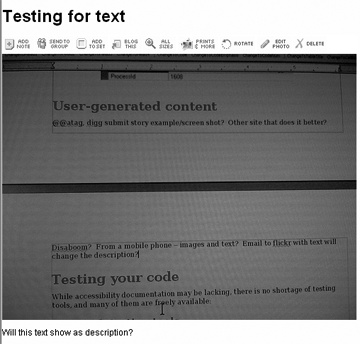User-Generated Content
Make it easy for users to generate accessible content. For example, Flickr allows users to upload photos from mobile phones via email. The subject of the email is used as the title for the photo and any text in the body is used for description, as shown in Figure 10-5.

Figure 10-5. A screenshot of Flickrâs page for a photo uploaded from a mobile phone
Digg could do something similar on its âstory submissionâ pageânot only asking for a thumbnail but also its alt text. Guidance on prompting users to generate accessible code is available from the Authoring Tools Accessibility Guidelines 2.0. The basic issues are:
Support the creation of accessible content (Guideline B.1.1).
Preserve accessible content as itâs added (Guideline B.1.2).
Generate accessible content (Guideline B.1.3).
Make the most accessible option the easiest one for the user to choose (Guideline B.3.1).
Prompt for and store alternate content for nontext objects (Guideline B.2.4).
Show authors how to create accessible content with your documentation and any templates you provide (Guideline B.2.5, Guideline B.3.5).
Get Universal Design for Web Applications now with the O’Reilly learning platform.
O’Reilly members experience books, live events, courses curated by job role, and more from O’Reilly and nearly 200 top publishers.

